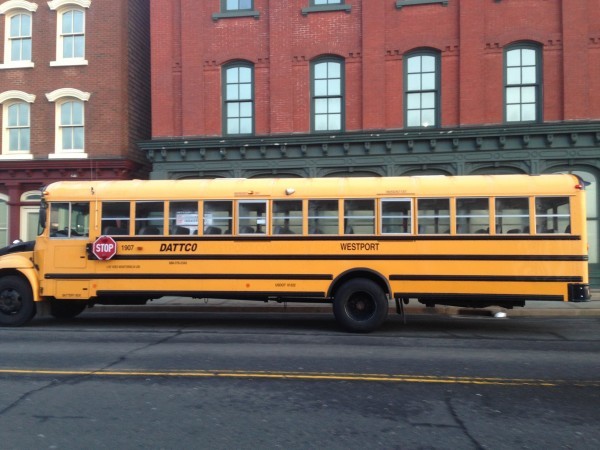School bus drivers are faced with the critical task of transporting upwards of 72 or more children to and from schools, along with ensuring the safety of every child onboard. Often perceived by some students as jungle gyms, free-for-alls or stomping grounds, these 10 ton yellow tanks can be tough for drivers to manage, especially when low pay and segmented scheduling does not ease the load.
Those circumstances along with other bureaucratic debilitations in the education system are a few of the major factors that contribute to the deficit of school bus drivers and the problems caused by the shortage.

Fewer Bus Drivers, Heavier Loads
Officials in school districts continuously tackle the bus driver shortage, yet there are always heavy lulls in hiring. With other driving opportunities available at higher wages, more working hours, and no children to handle, many drivers are gravitating toward commercial driving, steering clear of pupil transportation. This trend directly affects the amount of talent districts are able recruit to drive their buses, and forces existing school bus drivers to take on heavier loads.
Drivers now have to make multiple runs in the morning or afternoon and cover stops outside of their routes to accommodate the growth in student ridership and lack of certified drivers.
For veteran drivers, having control over a busload of youth while driving can be effortless, but for newer drivers, the undertaking can be daunting and discouraging. Unruly children, bullying, fighting, and other nuisances are the responsibility of the driver, and since bus helpers are becoming a thing of the past, that added sole pressure to maintain stability can mount on a person and take its toll.
Poor behavior and discipline on buses is difficult to curb sometimes, especially with elementary students who were cooped up inside on a rainy day and lots of middle-aged school children. Given that the cultural norms have changed, students have less respect than earlier generations did, which is not conducive to a functional and healthy workplace for school bus drivers.
Traffic Congestion and Environmental Ramifications
School districts are constantly faced with the ever-inviting task of making their budget stretch in order to meet more or essential needs of schools. More often than not, officials look toward school transportation to make cuts, which can mean a number of things including: eliminating bus routes to save on fuel cost, reducing services for children, or disallowing field trips or events that require scheduled buses.
These cuts might seem practical for budgetary purposes, but the environmental correlations are staggering.
Frustrated parents are now either forced to drive their children to school or choose to because they feel bus stops are not close enough to their homes. Traffic in school zones already accounts for 20 to 30 percent of congestion as it stands, but with the influx of more vehicles carrying fewer people, traffic jams are becoming increasingly hazardous. More vehicles on the road are not only causing headaches for drivers, they are also affecting the air quality for children who walk or bike to school.
Greater amounts of vehicles equal greater carbon emissions and can induce asthma and lung issues at an early age. Additionally, the likelihood of motorized, pedestrian or biking accidents is amplified if traffic flows escalate in areas surrounding schools.
Schedules Affected By The Shortage
The lack of drivers or substitute drivers is having a direct impact on how students’ time is spent. More students are missing out on instructional time in the morning because drivers have to make a second trip to retrieve children on routes without drivers. This affects not only the students arriving tardy, but also the teachers, administrative staff and fellow pupils when tracking attendance.
Furthermore, students are arriving at their homes up to an hour late because they have to wait for drivers to return from their first run.
Another scheduling conflict that drivers are faced with is the split shift scheduling during the day. Drivers often wake up at 4 a.m. or earlier in order to start their routes on time, and then have an afternoon shift that cuts right into the middle of their day, often preventing them from picking up other part-time work.
Hiring and Admiring From Within
In some districts, drivers are incentivized with bonuses if they can recruit drivers into their fleet. Bonuses are also awarded to drivers without any absences or accidents in a particular period, and are recognized during appreciation events in an attempt to keep morale high and create a positive work force. They also have the opportunity to earn certificates by completing classes, resulting in an increase in pay.
Additionally, bus helpers that are still utilized are being encouraged to get qualified as drivers since they already know the routes and are familiar with the school bus environment.
What’s Being Done About The Shortage
School districts are essentially using any methods they can to advertise job openings for school bus drivers. Advertisements for bus drivers are now plastered on the sides of buses, placed in student newsletters, and seen in other fashions. The Department of Education is also attempting to curb the shortage by offering classes for people who might have an interest working as a school bus driver and also encourage them to obtain the credentials needed.
Other actions school districts are considering are privatizing transportation. Most districts operate their schemes; however, they are finding that outsourcing some of their transportation needs would be more economical for the time being since they cannot afford new buses or provide them enough drivers in a scarce job market.
http://www.tampabay.com/news/education/k12/low-pay-high-expectations-fuel-shortages-of-school-bus-drivers/2113743
http://www.houstonchronicle.com/news/transportation/article/In-Katy-bus-driver-shortage-leads-to-parent-5360517.php
http://www.schoolbusfleet.com/List/Tag/driver-shortage.aspx
http://www.bls.gov/ooh/transportation-and-material-moving/bus-drivers.htm
The author, Christina DeParis, is a bus driver for the Seminole County School District for her regular job. But to help fill the time between the start and end of the school day and supplement income she will write on the side about various topics. If you are interested in becoming a bus driver and need somebody to give a dot certification physical exam, she highly recommends going to Driver Physicals.com to find a qualified physician near you.



